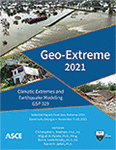Sensitivity of Site Response Analyses to Input Motion Selection Protocols
Publication: Geo-Extreme 2021
ABSTRACT
Input (bedrock) ground motions are a critical component of site-specific evaluations of earthquake effects. In this study, we investigate the sensitivities of site-response predictions to input motion selection protocols for different types of site conditions. Analyses are performed for alternative profiles (soft and stiff) in two sedimentary basins, Seattle, Washington, and Boston, Massachusetts, to evaluate the influence of different tectonic, geologic, and geotechnical conditions. Using the results of probabilistic seismic hazard analyses at each site, we develop suites of input motions using alternative target spectrum definitions for various magnitude–distance combinations, perform one-dimensional site response analyses, and evaluate the resulting sensitivities of the site response predictions to the various input motion selection protocols. When the soil behavior is strongly nonlinear at soft sites, we find that the influence of input motion selection protocols on site-response uncertainty decreases significantly, and that nonlinear soil behavior can suppress the variability in surface ground motions. Analyses using alternative profiles indicate that predicted ground motions at stiffer sites are more greatly influenced by input motion selection protocols relative to softer sites where significant nonlinear behavior may occur.
Get full access to this article
View all available purchase options and get full access to this chapter.
REFERENCES
Abrahamson, N. A., and Gregor, N. (2018). HAZ45, Seismic Hazard Analysis Software, https://github.com/abrahamson/HAZ (last accessed 15 February 2021).
Ancheta, T. D., Darragh, R. B., Stewart, J. P., Seyhan, E., Silva, W. J., Chiou, B. S.-J., Wooddell, K. E., Graves, R. W., Kottke, A. R., Boore, D. M., Kishida, T., and Donahue, J. L. (2014). “NGA-West2 Database.” Earthq. Spectra, 30(3), 989–1005.
ASCE. (2017). Minimum Design Loads and Associated Criteria for Buildings and Other Structures, Standard ASCE/SEI 7-16. ASCE, Reston, Virginia, 800 p.
Baise, L. G., Kaklamanos, J., Berry, B. M., and Thompson, E. M. (2016). “Soil amplification with a strong impedance contrast: Boston, Massachusetts.” Eng. Geol., 202, 1–13.
Baker, J. W. (2011). “Conditional mean spectrum: Tool for ground motion selection.” J. Struct. Eng., 137(3), 322–331.
Bradley, B. A. (2010). “A generalized conditional intensity measure approach and holistic ground motion selection.” Earthquake Eng. Struct. Dyn., 39, 1321–1342.
BSSC (Building Seismic Safety Council). (2015). NEHRP Recommended Seismic Provisions for New Buildings and Other Structures (FEMA P-1050-1): Volume 1: Part 1 Provisions, Part 2 Commentary, Federal Emergency Mgmt. Agency, Washington, D.C., 555 pp.
Cabas, A., and Rodriguez-Marek, A. (2017). “VS-κ0 correction factors for input ground motions used in seismic site response analysis.” Earthq. Spectra, 33(3), 917–941.
Chowdhury, I. N., Cabas, A., Kaklamanos, J., Kottke, A., Gregor, N., and Lang, K. M. (2019). “Ground motion selection using the conditional spectrum: Insights for different tectonic environments.” pp. 1803–1811 in Proc. Seventh Int. Conf. on Earthquake Geotech. Eng., F. Silvestri and N. Moraci (eds.), CRC Press, 17–20 June 2019, Rome, Italy.
Darendeli, M. B. (2001). Development of a new family of normalized modulus reduction and material damping curves. Ph.D. Thesis, Univ. of Texas at Austin, Austin, Texas, 396 pp.
Galster, R. W., and Laprade, W. T. (1991). “Geology of Seattle, Washington, United States of America.” Bull. Eng. Geol. Environ., 28(3), 235–302.
Goulet, C. A., Kishida, T., Ancheta, T. D., Cramer, C. H., Darragh, R. B., Silva, W. J., Hashash, Y. M. A., Harmon, J., Stewart, J. P., Wooddell, K. E., and Youngs, R. R. (2014). “NGA-East Database.”, Pacific Earthquake Engineering Research Center, University of California, Berkeley, California, 124 pp.
Groholski, D. R., Hashash, Y. M. A., Kim, B., Musgrove, M., Harmon, J., and Stewart, J. P. (2016). “Simplified model for small-strain nonlinearity and strength in 1D seismic site response analysis.” J. Geotech. Geoenviron. Eng, 142(9), DOI: https://doi.org/10.1061/(ASCE)GT.1943-5606.0001496.
Hashash, Y. M. A., Musgrove, M. I., Harmon, J. A., Ilhan, O., Groholski, D. R., Phillips, C. A., and Park, D. (2018). DEEPSOIL 7.0, User Manual, Univ. of Illinois at Urbana-Champaign, Champaign, Illinois, 169 pp.
Kaklamanos, J., and Bradley, B. A. (2018). “Challenges in predicting seismic site response with 1D analyses: Conclusions from 114 KiK‐net vertical seismometer arrays.” Bull. Seismol. Soc. Am., 108(5A), 2816–2838.
Kaklamanos, J., Bradley, B. A., Moolacattu, A. N., and Picard, B. M. (2020). “Physical hypotheses for adjusting coarse profiles and improving 1D site response estimation assessed at 10 KiK-net sites.” Bull. Seismol. Soc. Am., 110(3), 1338–1358.
Okada, Y., Kasahara, K., Hori, S., Obara, K., Sekiguchi, S., Fujiwara, H., and Yamamoto, A., (2004). “Recent progress of seismic observations networks in Japan – Hi-net, F-net, K-net and KiK-net.” Earth Planets Space, 56, xv–xxviii.
Phillips, C., and Hashash, Y. M. A. (2009). “Damping formulation for nonlinear 1D site response analyses,” Soil Dyn. Earthq. Eng., 29, 1143–1158.
Rathje, E. M., Kottke, A. R., and Trent, W. L. (2010). “Influence of input motion and site property variabilities on seismic site response analysis.” J. Geotech. Geoenviron. Engin., 136(4), 607–619.
Shannon and Wilson. (2018). “Geotechnical data report, Stanford center liquefaction monitoring array, Seattle, Washington.”, Seattle, Washington, 333 pp.
Thompson, E. M., Carkin, B., Baise, L. G., and Kayen, R. E. (2014). “Surface wave site characterization at 27 locations near Boston, Massachusetts, including 2 strong-motion stations.”, 27 pp.
Woodhouse, D., and Barosh, P. J. (2011/2012). “Geotechnical factors in Boston.” Civil Engin. Practice, 26/27, 237–263.
Wong, I. G., Stokoe, K. H., Cox, B. R., Lin, Y.-C., and Menq, F.-Y. (2011). “Shear-wave velocity profiling of strong motion sites that recorded the 2001 Nisqually, Washington, earthquake.” Earthq. Spectra, 27(1), 183–212.
Information & Authors
Information
Published In
Copyright
© 2021 American Society of Civil Engineers.
History
Published online: Nov 4, 2021
Authors
Metrics & Citations
Metrics
Citations
Download citation
If you have the appropriate software installed, you can download article citation data to the citation manager of your choice. Simply select your manager software from the list below and click Download.
